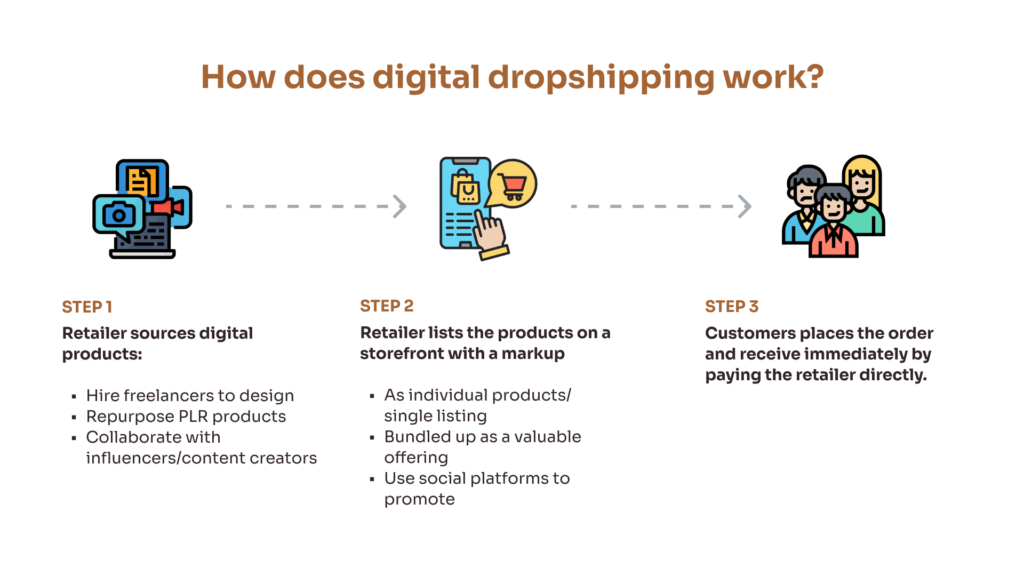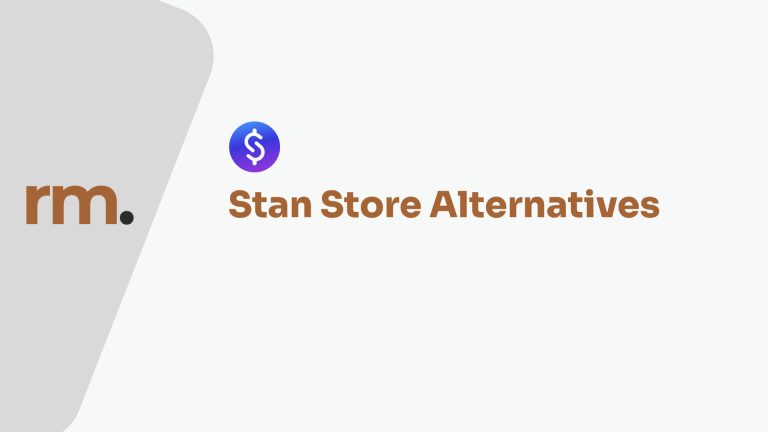Dropshipping has been a popular business model for many years, but with the rise of digital products, a new variation of this model has emerged: digital dropshipping.
In this article, we will delve into various aspects of digital dropshipping, including selecting a niche, partnering with digital product suppliers, setting up an online store, marketing your business, and scaling up for long-term success.
By understanding the intricacies of this e-commerce model and following a strategic approach, you can establish a thriving digital dropshipping business that meets the needs and preferences of your target audience.
Digital dropshipping is a unique e-commerce model that involves the online sale of digital products, such as e-books, online courses, software, digital artwork, and more.

Unlike traditional dropshipping, which primarily deals with physical products, digital dropshipping focuses on intangible goods that can be easily delivered through the Internet.
As a digital drop shipper, you can capitalize on the growing demand for digital products while enjoying the benefits of lower overhead costs, easier inventory management, and instant delivery to customers.
As the digital landscape continues to expand, digital dropshipping offers a promising opportunity for entrepreneurs and businesses alike. Read on to learn more about this innovative business model and gain valuable insights on how to get started on your digital dropshipping journey.
Understanding Traditional vs Digital Dropshipping
The ever-evolving e-commerce landscape has given rise to various innovative business models, one of which is digital dropshipping. As more people seek convenient and efficient ways to access products and services online, digital dropshipping has emerged as a viable alternative to traditional retail methods.
The table below illustrates the differences between traditional dropping and digital dropshipping.
| Traditional Dropshipping | Digital Dropshipping | |
| Definition | Where a seller sets up a website and sells physical products that the seller does not keep in stock. When an order is placed, the seller sends it to a third party — the manufacturer, another retailer, or a wholesaler — who ships the goods directly to the buyer. | Where a seller obtains the rights to resell digital products. There’s no physical movement of goods given the nature of these digital products. |
| Fulfillment | The third-party supplier manages the logistics of delivering the goods to the customer. | When a customer makes a purchase, the digital product is delivered electronically, usually via email or a download link. |
| Lead times | Can vary depending on various factors (usually 1 – 2 weeks if the supplier is in China) | Immediate |
| Product range | Limited to products offered by suppliers who will in turn supply to various other drop shippers making it very saturated and competitive. | You can easily craft and bundle up your offerings to suit the needs of your target audience making the products unique and less competitive. |
| Profit margins | Varies and is usually low after considering shipping fees, warehousing, defects, returns, etc. | Almost 95% margin as there are no manufacturing, inventory, or shipping costs involved. |
| Geographic Reach | Limited to areas where the suppliers can deliver the products to. | Deliver the products digitally to anyone with an internet connection! |
| Returns/Refunds | Customers will request a refund/return if the product is physically defected or damaged. This can eat into your margins. | With no physical product to worry about, there’s no need to deal with the hassle of refunds for damaged goods. |
Benefits of Digital Dropshipping
- Lower Startup Costs: One of the main benefits of digital dropshipping is the reduced startup costs and overhead. Since there’s no need to invest in inventory, storage, or shipping, entrepreneurs can start their businesses with minimal capital. This makes it an accessible and attractive option for aspiring business owners.
- Scalability: Digital dropshipping is highly scalable because there’s no limit to how many digital products you can sell. Additionally, since you don’t need to manage inventory, it’s easier to expand your product offerings and reach a broader audience.
- Diversified Product Range: With digital dropshipping, you can offer a wide variety of digital products, from ebooks to software, giving you the opportunity to cater to various niches and customer needs.
- Improved Customer Experience: Customers enjoy instant access to their purchased digital products, which can result in higher customer satisfaction and repeat business.
How to Get Started with Digital Dropshipping
- Choose a Niche: Finding a niche is crucial for any dropshipping business. When it comes to digital dropshipping, focus on a specific interest or topic, such as fitness, personal development, or graphic design.
- Research Competitors: Analyze your competition to understand the market demand, pricing strategies, and marketing techniques. This will help you create a unique value proposition and position your business effectively.
- Find reliable suppliers: It’s crucial to find trustworthy suppliers for your digital products. Look for suppliers with good reputations, reasonable pricing, and responsive customer service. Platforms like Gumroad and Teachable are great options for finding digital product suppliers.
- Select a Platform: Choose an eCommerce platform to host your digital dropshipping store. Popular options include Shopify, WooCommerce, and BigCommerce. These platforms offer various tools and features to help you manage your store efficiently.
- Promote your store: Once you have the storefront setup, it’s time to get it in front of as many eyes as possible. Use various strategies to get the attention of your potential customers including influencer marketing, hiring affiliates and running paid campaigns.
Types of products to sell through digital dropshipping
One of the key advantages of digital dropshipping is the wide variety of digital products available to sell. It’s important which of types of digital products are best suited for you to sell.
These products, which can be easily delivered online, offer numerous opportunities for entrepreneurs to tap into different niches and cater to diverse customer needs.
In this section, we will discuss the most popular types of digital products for dropshipping and provide insights into their unique features and benefits.
1. E-books
E-books are electronic versions of traditional books, making them easily accessible and downloadable for readers worldwide. As a digital dropshipper, you can offer e-books in various genres and topics, including fiction, non-fiction, self-help, educational materials, and more.
Since e-books do not require printing or shipping costs, they can be an affordable option for both sellers and consumers. Moreover, you can work with authors or partner with e-book distributors to access a vast library of titles for your online store.
2. Online courses
Online courses have gained immense popularity in recent years, as people increasingly turn to the internet for learning and personal development. Digital dropshipping businesses can capitalize on this trend by offering courses in various subjects, from business and marketing to photography and cooking.
You can partner with established online education platforms or individual course creators to provide a diverse range of learning options for your customers. Additionally, you may choose to offer courses in different formats, such as video, audio, or text-based content, to cater to various learning preferences.
3. Digital artwork and designs
Digital artwork and designs encompass a broad spectrum of creative assets, such as graphic designs, illustrations, website templates, and social media graphics.
These products are particularly appealing to businesses and individuals seeking unique and customizable visuals for their marketing campaigns or personal projects.
By partnering with talented designers or sourcing digital assets from popular marketplaces, you can build a lucrative digital dropshipping business that caters to the growing demand for high-quality creative content.
4. Software and apps
The software and app market is continually expanding, presenting numerous opportunities for digital dropshippers. You can offer various types of software and apps, ranging from productivity tools and video editing software to mobile games and fitness apps.
To ensure customer satisfaction, it’s essential to work with reliable developers or distributors who provide regular updates, bug fixes, and customer support for their products.
You can also offer additional services, such as installation assistance or software customization, to enhance the customer experience and increase your business’s value proposition.
5. Audio and video content
Audio and video content, such as podcasts, music tracks, stock footage, and sound effects, can be another profitable niche for digital dropshippers.
These products are in high demand among content creators, filmmakers, advertisers, and other professionals who require multimedia assets for their projects. By partnering with content producers or sourcing media from reputable platforms, you can offer a diverse range of audio and video assets that cater to various customer needs and preferences.
6. Website themes and templates
As more businesses and individuals establish an online presence, the demand for website themes and templates continues to grow. By offering professionally designed themes and templates compatible with popular content management systems, such as WordPress or Shopify, digital dropshippers can cater to customers seeking to build or revamp their websites.
It’s crucial to work with skilled designers or theme developers who provide ongoing support, updates, and customization options to ensure a positive customer experience.
Choosing the right suppliers for your digital products
One of the crucial steps in building a successful digital dropshipping business is finding and partnering with reliable digital product suppliers. These suppliers play a significant role in ensuring that your customers receive high-quality digital products while allowing you to focus on marketing and growing your business.
Here’s how you’d go about identifying potential suppliers for your digital dropshipping business.
Popular platforms and marketplaces
There are several platforms and marketplaces where you can find digital product suppliers for your dropshipping business. Some of the most popular ones include:
- ClickBank: A leading digital product marketplace that offers a wide range of digital products, such as e-books, software, and online courses, across various niches.
- Gumroad: A platform that allows creators to sell digital products, including e-books, music, software, and more.
- Teachable and Udemy: Online course platforms that enable instructors to create, host, and sell their courses.
- Envato Market: A digital marketplace that offers various digital products like website themes, plugins, graphics, and audio files.
- Fiverr and Creative Market: Platforms that connect creators of digital artwork, designs, and templates with buyers.
Research and explore these platforms to find potential suppliers that align with your chosen niche and target audience.
Criteria for choosing suppliers
Once you have identified potential suppliers, it is essential to evaluate them based on specific criteria to ensure that you are partnering with the right ones. Some key factors to consider include:
- Product quality: The quality of digital products is paramount to your business’s success. Ensure that the suppliers you choose offer high-quality products that meet the needs and preferences of your target audience. You can assess product quality by checking customer reviews, ratings, and testimonials.
- Customer support: Partner with suppliers who offer excellent customer support and are responsive to your queries and concerns. This will enable you to address any issues that may arise promptly, ensuring that your customers have a positive experience with your business.
- Licensing and usage terms: Understand the licensing and usage terms associated with the digital products you intend to sell. Some suppliers may have specific restrictions on how their products can be used, so it is crucial to ensure that you can comply with these terms before partnering with them.
Building and maintaining relationships with suppliers
Once you have selected your digital product suppliers, it is essential to build and maintain strong relationships with them. This can help ensure a smooth and efficient collaboration, ultimately leading to your business’s success. Here are some tips for fostering positive relationships with your suppliers:
- Communicate effectively: Maintain open lines of communication with your suppliers, keeping them informed about any changes or updates in your business. Ensure that you respond to their messages promptly and professionally.
- Be transparent and honest: Share your expectations and goals with your suppliers and encourage them to do the same. Being transparent and honest in your dealings can help build trust and mutual understanding.
- Show appreciation: Recognize and appreciate the efforts of your suppliers. Express gratitude for their support and collaboration, and consider offering incentives or bonuses for exceptional performance.
- Resolve conflicts amicably: Disagreements and conflicts may arise from time to time. Handle these situations professionally and amicably, seeking solutions that benefit both parties.
Setting Up Your Online Store
Creating a user-friendly, attractive, and functional online store is essential for the success of your digital dropshipping business. This platform will serve as the foundation of your enterprise, allowing customers to browse, purchase, and access your digital products with ease.
Here’s how you would go about setting up a digital dropshipping store:
- E-commerce platform options: There are several e-commerce platforms available, each offering different features and capabilities tailored to various business requirements. Some popular options include Shopify, WooCommerce, BigCommerce, and Magento. Evaluate your specific needs, budget, and technical expertise to determine the platform that best suits your digital dropshipping business.
- Customizing your store’s design and functionality: Once you’ve chosen an e-commerce platform, focus on creating a visually appealing and easy-to-navigate store. Customize your store’s theme, layout, and branding to reflect your niche and target audience. Ensure that your website is mobile-responsive and loads quickly, as these factors significantly impact user experience and search engine rankings.
- Creating product listings and descriptions: Craft compelling product listings that accurately represent your digital products and highlight their unique selling points. Optimize your product descriptions with relevant keywords to improve search engine visibility. Use high-quality images, screenshots, or demo videos to give customers a clear understanding of what they can expect from your digital offerings.
- Implementing payment gateways and shipping options: Integrate secure and reliable payment gateways to process transactions, such as PayPal, Stripe, or Square. Although digital products do not require physical shipping, you still need to establish a system for delivering purchased items to customers, such as automatic email delivery or secure download links. Ensure that your chosen delivery method is efficient, user-friendly, and safeguards your digital products from unauthorized access.
How to manage customer support for digital products
Once you have the store up and running, you’d need to make sure to provide great after-sales service. This is important as it would allow you to increase the average order value per customer which is a key metric for digital dropshippers.
Offering customer support
- Offer multiple communication channels: Providing various ways for customers to reach out, such as email, live chat, and social media, ensures that they can contact you through their preferred method. Be responsive and attentive across all channels.
- Create a comprehensive FAQ page: A well-organized and thorough FAQ page can address common customer concerns, saving time for both the customers and your support team. Update this page regularly to include new information and ensure its relevance.
- Provide clear product information: Detailed product descriptions, usage instructions, and tutorials can help prevent misunderstandings and reduce the need for support. Be transparent about your policies and terms of service.
- Offer prompt and efficient support: Train your support team to resolve issues quickly and professionally. Establish standard operating procedures (SOPs) for common scenarios, and track key performance indicators (KPIs) to measure and improve your support team’s performance.
- Personalize the customer experience: Make customers feel valued by personalizing interactions, addressing them by name, and offering tailored recommendations.
Handling Returns and Refunds
- Implement a clear return and refund policy: Clearly outline the conditions under which customers can request a return or refund. For digital products, this may include cases of non-delivery, technical issues, or product misrepresentation. Display your policy prominently on your website and in your communication materials.
- Offer a reasonable return window: Determine an appropriate timeframe within which customers can request returns or refunds. For digital products, a 7-30 day window is common. Consider offering a money-back guarantee to build trust and confidence in your products.
- Manage return requests efficiently: Develop a system to track and process return requests promptly. This may include using customer support software or a ticketing system. Ensure that your team is well-versed in your return and refund policy to provide accurate information to customers.
- Learn from returns and feedback: Analyze return requests and customer feedback to identify trends and areas for improvement. Use this information to enhance your products, services, and support strategies.
Protect Against Fraud
- Implement secure payment systems: Choose a reputable payment gateway that employs robust security measures to prevent fraud and protect sensitive customer information.
- Monitor for suspicious activity: Keep an eye on unusual patterns or trends that may indicate fraudulent behavior, such as multiple refund requests from the same customer or unusual spikes in return rates. Investigate these cases and take appropriate action.
- Set clear terms and conditions: Clearly state the acceptable use of your products and services, including licensing terms and restrictions. This can help protect your business from unauthorized distribution or misuse of your digital products.
By implementing these strategies, you can effectively manage customer service, support, and returns for your digital dropshipping store, ensuring a positive customer experience and fostering long-term relationships.
Final thoughts
Phew! We covered a lot of ground and you probably are quite overwhelmed at this point. But the key thing is to take it step-by-step. I’ve also expanded this into a more actionable guide that you can download for future reference.
If you are interested in starting up a dropshipping business and need more information, get in touch with me via Instagram.



